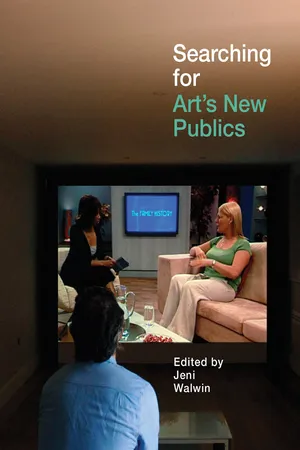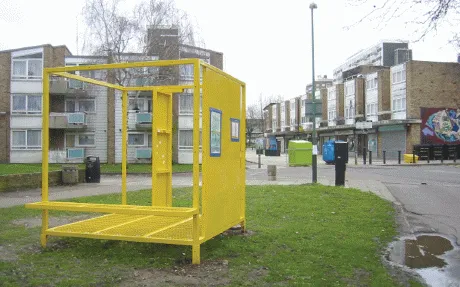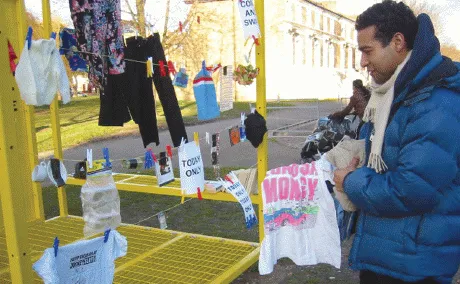
Searching for Art's New Publics
- 160 pages
- English
- ePUB (mobile friendly)
- Available on iOS & Android
Searching for Art's New Publics
About this book
Drawing on contributions from practicing artists, writers, curators, and academics, Searching for Art's New Publics explores the ways in which artists seek to involve, create and engage with new and diverse audiences—from passers-by encountering and participating in the work unexpectedly, to professionals from other disciplines and members of particular communities who bring their own agendas to the work. Bridging the gap between practice and theory, this exciting book touches on issues of relational aesthetics, but also offers an illustrated artist-based approach. Searching for Art's New Publics will appeal to students studying fine art (especially those with an interest in cross-disciplinary work and public art) and those studying curating.
Frequently asked questions
- Essential is ideal for learners and professionals who enjoy exploring a wide range of subjects. Access the Essential Library with 800,000+ trusted titles and best-sellers across business, personal growth, and the humanities. Includes unlimited reading time and Standard Read Aloud voice.
- Complete: Perfect for advanced learners and researchers needing full, unrestricted access. Unlock 1.4M+ books across hundreds of subjects, including academic and specialized titles. The Complete Plan also includes advanced features like Premium Read Aloud and Research Assistant.
Please note we cannot support devices running on iOS 13 and Android 7 or earlier. Learn more about using the app.
Information
Part I
Participation: Open or Closed
Chapter 1
The Anatomy of a Participatory Project
EXT. STREET SCENE — DAYTIME
This is the Granville Cube.
INT. BUSY STUDIO — DAYTIME
And this is the studio of public works, a group of artists and architects who instigated the Granville Cube. I’m here to ask them how they view their role in the project, as authors of the situation, perhaps, or facilitators of an ongoing series of micro-projects. First, though, we need to address a fundamental question.
CLOSE-UP OF STUDIO TABLE TOP — DAYTIME
Why are participatory art projects so unphotogenic? Documentation of public events, whether donkey derbies, knitting marathons or snacking sessions, do not serve the visual art publication well. They look just like the jumble of ordinariness that life is generally made up of.
INT: EMPTY WHITE GALLERIES — DAYTIME
Rirkrit Tiravanija, the golden boy of relational aesthetics, forsook imagery entirely in his Palais de Tokyo retrospective, instead relying on spoken commentary delivered through headphones to evoke past projects.
INT. CLOSE-UP OF STUDIO TABLE TOP — DAYTIME
While the composed or fortuitously grasped photographic moment speaks of virtuosity based in aesthetic judgement, the snapshot displaces classical composition with visual disorder. The participatory project, too, replaces the primacy of the well-ordered image with a hidden structure or concept that is equally authored, but whose outcome is less controlled or visually apparent.
INT. GALLERY — DAYLIGHT
In 1971, for his retrospective at the Tate Gallery, Robert Morris fabricated a large installation that the audience could clamber over in an infamous response to the idea of the ‘open work’. The open work, as described by Umberto Eco, was kinetic, shattering the traditional fixity of optical reception. The simple fact of its movement was radical enough back then it seems.
Could we say you always had a suspicion of the image? After all, greyness seems to predominate? No optical celebration of lush surfaces are to be found in your oeuvre. Your strategies had more to do with locating conditions that generated objects and divided spaces. Still, we are left with images when all is said and done. No, you are left with photographs and words when all is said and done. Still, there seems to have been in the past a certain resistance to the ‘image’, as if this offered you a certain purchase, a certain foothold (pardon the image here) from which to work. And how does such a stance feel today? Well, it is like standing in a station platform watching the express go by.2
Critic Michael Shepherd found this lack of emphasis on the image most disconcerting, as if its displacement were a regressive barbaric act.
CLOSE-UP OF BEARDED MAN IN SUIT
The trouble with participation, it seems, is that apart from making us forget what art’s all about, and inducing the very restlessness of mind which it’s suppose to ease, it makes people behave like wild beasts…3
EXT. STREET SCENE — DAYTIME




So here we are, back at the Granville Cube. I have to say that rather than behaving like wild beasts, the Cube seems to have a very different effect on the locals. Chris, you work on the council regeneration scheme. Can you tell me about your involvement in the Granville Cube and the problems and benefits it presents?
Sure. My predecessor commissioned the cube as part of a regeneration programme and the question was how to involve the local residents, how to get them to claim ownership of their community. The Cube is literally a skeleton. There were concerns from local business owners that it would encourage anti-social behaviour, but it hasn’t, it’s been adopted by everybody. You have local dance groups, people putting on celebrations, workshops. It’s a free-spirited piece of public furniture. It’s a bench that could be deemed to be dangerous – there are corners on there. The borough is taking a bit of a risk in that hasn’t been sanitised or made very, very safe, given soft edges and so on.
EXT. STREET SCENE — DAYTIME
As we saw earlier, participatory practice, socially engaged or open artworks, call it what you will, are not new, and neither are the attendant health and safety issues. While we talk about the new North American-style litigious culture in Europe, even back in 1971 Robert Morris’s installation was closed after five days because of splinters. Artists know only too well the frustrations of health and safety, but they also know some cunning ways to get around it. This is a traditional Dutch street game that represents capturing land and marking territory. The artist Jeanne van Heeswijk proposed a re-presentation of the game in a gallery context but, when it came to the issue of the knife, this was vetoed on health and safety grounds. Van Heeswijk got around the problem by commissioning another artist to make a knife so that it was a ‘collaborative sculpture’ and therefore bypassed the usual evaluative procedures.
INT. LECTURE THEATRE
This incident is a rather cynical example of the perceived status of ‘collaboration’ as a cultural process. It implies cross-fertilisation between disciplines, which in turn has implications for audiences, which opens doors and purses alike. Artist and critic Dave Beech has been carefully reappraising words like ‘collaborator’ and ‘participant’, dissecting them for their ethical implications.
In contemporary art, though, the difference between interactivity, participation, collaboration and co-operation, not to mention collectivity, is measured in terms of a sliding scale of the degree to which the work’s public is active within the work, including, crucially, how early or late that activity is […]
Table of contents
- Cover
- Title Page
- Copyright
- Contents
- Acknowledgements
- Preface
- Introduction
- Keynote Essay: Don’t Look Now! Art after the Viewer and beyond Participation
- Part I: Participation: Open or Closed
- Part II: Sonic Openness
- Part III: The Emancipation of the Spectator: The Viewer Completes the Circuit
- Part IV: The Art Object Reaches Out: Dissolves, Embraces
- Contributors’ Biographies
- Index
- Credits